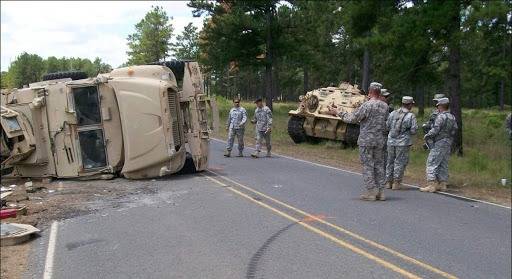It’s 3:30 a.m. and your patrol is rumbling forward off-road at a steady pace. The column is silent, except for the low, constant hum of the vehicles crawling forward. The silence is punctured by a sudden crash. You briefly see the vehicle ahead of you flip over and roll into a ditch. At best, no one has been hurt and you’ll be sitting ducks until the convoy can get moving again. At worst, your colleagues have been pinned under the vehicle and have been seriously injured or killed.
An increase in fatalities caused by military vehicle rollovers last year and in the early months of 2020 have prompted U.S. military leadership to pay closer attention to the issue. Although most recent accidents have taken place during training, a growing trend of vehicle rollovers began to emerge amongst certain vehicle types in 2003 and persisted throughout Operation Iraqi Freedom (OIF) and Operation Enduring Freedom (OEF). Identifying which military vehicles are prone to rolling over would pave the way for greater occupant safety in vehicles when deployed and in training.
Determining which vehicles are most prone to rolling over is not a straightforward task. For instance, in 2010, researchers from the Naval Health Research Center found that many records did not list the vehicle involved in an accident when gathering data for their report on noncombat motor vehicle accidents during OIF.
However, a combination of statistical and anecdotal data has made it clear which vehicles were most involved in rollover accidents at the height of OIF and OEF.
A 2017 study in the Military Medicine journal reveals that reports of rollover fatalities involving the High-Mobility Multipurpose Wheeled Vehicle (HMMWV) increased between 2003 and 2005. This timeframe coincides with the military’s HMMWV up-armoring program which made the vehicles more capable of protecting their occupants from IED blasts and small arms fire.
An unintended consequence of the up-armoring program was the transformation of the HMMWV from a relatively agile and maneuverable vehicle to that of a hulking and unwieldy beast. The threat posed by IEDs may have been reduced but now the rough terrain and poorly maintained roads of Iraq and Afghanistan had become a dangerous antagonist for troops attempting to negotiate steep inclines or unfamiliar routes.
A recent accident occurring in October 2019 serves as a painful reminder of the up-armored HMMWV’s susceptibilities to rolling over. Marine Pfc. Christian Bautista was killed when the M1151 HMMWV he occupied rolled over during a training exercise at the Marine Corps Mountain Warfare Training Centre in Bridgeport, California,
In 2007, U.S. forces adopted an alternative to the Frankenstein’s monster, which the up-armored HMMWV had become, with the newer Mine-Resistant Ambush Protected (MRAP) vehicles. With their V-shaped hulls and heavier armor, the MRAP was better suited to protecting troops from IEDs than the up-armored HMMWV. They were not, however, any better at traversing Iraq and Afghanistan’s uneven roads and terrain.
The vast majority of MRAPs adopted by U.S. forces in 2007 were based on earlier African designs. The first MRAPs deployed in the 1970s during the Rhodesian Bush War were predominately operated in the flat open terrain of the savanna. In contrast, the descendants of these early MRAPs were confronted with the steep inclines and uneven trails of Iraq and Afghanistan. This factor combined with the MRAP’s significant weight and high center of gravity has made it especially prone to rollovers.
Other vehicles, which are not inherently prone to rolling over due to their designs are nevertheless at an elevated risk of a rollover due to their role and usage. Last year, a LAV-25 and Polaris MRZR were both implicated in rollovers which led to training fatalities. The LAV-25 is used by the U.S. Marine Corps in an armored reconnaissance role, whereas the MRZR is specifically designed for off-road usage Consequently, both vehicles are frequently operated in terrain which may inhibit driver visibility or cause a loss of control, thus heightening the probability of a rollover.
Vehicles identified as being at a higher risk of accidents and rollovers should be the priority when military leadership are considering new technology, training and practices which may be implemented to improve vehicle safety.

